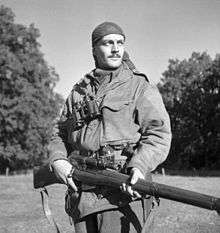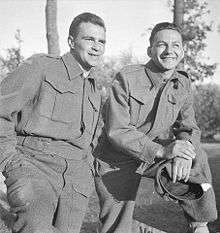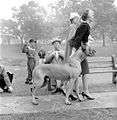Ken Bell
| Ken Bell | |
|---|---|
 | |
| Born |
July 30, 1914 Toronto, Canada |
| Died |
June 26, 2000 (aged 85) Gibsons, British Columbia, Canada |
| Allegiance | Canada |
| Service/branch | Canadian Army |
| Rank | Lieutenant-Colonel |
| Unit | Canadian Army Film and Photo Unit |
| Commands held | Royal Regiment of Canada |
| Battles/wars | Normandy landings |
| Other work | photographer |
Ken Bell (July 30, 1914 – June 26, 2000) was a Canadian photographer who served with the Canadian armed forces during the Second World War. As a Lieutenant in the Canadian Army Film and Photo Unit, he participated in the Normandy Landings, photographing and recording the liberation of France, Belgium and the Netherlands, and finally documenting the occupation of Germany. After the war he had a successful career as a professional photographer, and published a number of books including Not in Vain, a collection of photographs showing the changes which had taken place in Europe since the end of the war.
Early life
Bell was born in Toronto, Ontario, on July 30, 1914. He was the oldest of five children born to carpenter Charles Bell (1881–c. 1958) and Edith Bell, both from Yorkshire, England.[1] They lived at 1211 Dufferin St, Toronto.[2]
World War II

When Canada joined the war against Nazi Germany in 1939, Bell was posted to Ottawa as a public relations photographer.[3] Later, he joined the Canadian Army Film and Photo Unit, with the rank of lieutenant. Along with a number of other photographers, Bell would go on to document Canada's participation in World War II.[4]
The Canadian Army played a major role in the 1944 Normandy landings, landing at Juno beach, somewhat to the south of the previous raid at Dieppe in 1942. Like his better known American contemporary Robert Capa, Bell took part in the first day of the D-Day operation, disembarking at Juno Beach on June 6, 1944 with The Highland Light Infantry of Canada (now known as the Royal Highland Fusiliers of Canada), part of the 9th brigade. The 9th brigade was not in the first assault wave, but landed later in the morning and advanced through the lead brigades, which had taken heavy casualties.[5]
Many of Bell's photographs were taken in colour - a first for the Canadian Army - though these did not become public until around twenty years later. They are the only surviving colour photographs of the Normandy Landings.[6]
Members of the CFPU were often in the front line,[7] and sometimes even ahead of it. During the liberation of Dieppe in 1944, as the Manitoba Dragoons awaited orders to advance, members of the CFPU including Ken Bell and Brian O'Regan were the first Allied servicemen to enter the town.[8]
Bell's war photographs – taken with a Rolleiflex camera – are housed by the Library and Archives of Canada in Ottawa.[9] Many of the original negatives of his photographs are held by the Canadian Forces Photo Unit and the City of Toronto Archives.
Post-war career
After the war Bell had a successful career as a professional photographer, publishing a number of collections of photographs taken during and after the war.
He also continued with an active role in the Canadian Army as an Officer Commanding of the Royal Regiment of Canada and then as the regiment's Honorary Lieutenant-Colonel.
In 1953 he published Curtain Call, a collection of photographs in which he "tried to show the changes brought by man and nature in the 5 years since VE day". This was followed in 1973 by Not in Vain, published by the University of Toronto Press, a collection of photographs taken partly during the war, and partly 25 years later when he returned to the same locations in France, Belgium and the Netherlands.[10]
During the 1970s he worked as a freelance photographer, specialising in fashion, food and work in the advertising industry. He also had a long professional association with the National Ballet of Canada.[3]
In 1990, he collaborated with Desmond Morton to publish a book detailing the history of the Royal Canadian Military Institute on the occasion of the Institute's 100th Anniversary.
Family life
Colonel Bell was twice married. His first was to Molly, with whom he adopted two daughters, Sue and Karen. After Molly's death he married Mary Lea Kenly of Toronto.
His nephew Richard Williams is a noted Canadian animator.
He died on June 26, 2000, in Gibsons, British Columbia, Canada.
Awards
He was twice awarded the Photographer of the Year award by the society of Professional Photographers of Canada, in 1965 and 1966.[11] In 1986 he received the Canadian Association of Photographers and Illustrators Lifetime Achievement Award.[12]
Published works
- Curtain Call, Intaglio Gravure Limited 1953
- Not in Vain, University of Toronto Press, 1973, ASIN: B001PQT32Y
- 100 years: The Royal Canadian Regiment, 1883-1983, Collier Macmillan Canada, 1983 ASIN: B000KFWQ16
- The Way We Were, University of Toronto Press, 1988 [13]
- Royal Canadian Military Institute: 100 Years 1890-1990, Morton and Bell, 1990.
Gallery
 Sgt H A Marshall of the Sniper Section, Calgary Highlanders.
Sgt H A Marshall of the Sniper Section, Calgary Highlanders. Panzerschrek
Panzerschrek Royal Winnipeg Rifles
Royal Winnipeg Rifles Crowded beach at Courseulles-sur-Mer
Crowded beach at Courseulles-sur-Mer Canadian infantry reinforcements arrive at Courseulles-sur-Mer. Photo by Ken Bell
Canadian infantry reinforcements arrive at Courseulles-sur-Mer. Photo by Ken Bell A Canadian soldier fires on the enemy in a house in Caen, July 10, 1944.
A Canadian soldier fires on the enemy in a house in Caen, July 10, 1944. Unidentified Canadian Infantry in a Bombed Out Church in Carpiquet, near Caen, July 12, 1944
Unidentified Canadian Infantry in a Bombed Out Church in Carpiquet, near Caen, July 12, 1944 Highlanders
Highlanders Canadian Private MacDonald gives first aid to a child
Canadian Private MacDonald gives first aid to a child 1st Canadian generals
1st Canadian generals Wayne and Shuster
Wayne and Shuster Canadian Soldiers Juno Beach
Canadian Soldiers Juno Beach Two women walking a great dane in High Park in Toronto
Two women walking a great dane in High Park in Toronto
References
- Bell, Ken Not in Vain, University of Toronto Press, 1973 ISBN 0-7153-5855-3
- Chartrand, Rene, & Volstad, Ronald, p.21, Canadian Forces in World War II Retrieved September 2011
- Ford, Ken, and Peter Dennis, Caen 1944: Montgomery's Break-out Attempt Retrieved September 2011
- Ford, Ken, p.28, Falaise 1944: Death of an Army Retrieved September 2011
- Hunter, Martin Young Hunting - a memoir ECW Press, Toronto, Ontario, 2008 ISBN 978-1-55022-852-6
- O'Regan, Bryan, Camera Commandos and Reminiscences of D-Day Normandy, E Book, 2007, ISBN 978-0-9731985-3-9
- O'Regan, Bryan, Shooters, documentary film about the CFPU.
- UK census records, 1911.
- Zuehlke, Mark, p.182, Breakout from Juno: First Canadian Army and the Normandy Campaign Retrieved September 2011
Notes
- ↑ UK census records, 1911
- ↑ Hunter, Martin, p.35
- 1 2 Art et Architecture au Canada : Bibliographie et Guide, by Loren Ruth Lerner, Mary F. Williamson Retrieved September 2011
- ↑ "Ken Bell" Encyclopædia Britannica online Retrieved August 9, 2010
- ↑ Juno Beach webpage Retrieved September 2012
- ↑ O'Regan p18
- ↑ Battle Diary: From D-Day and Normandy to the Zuider Zee and VE Day, by Charles Cromwell Martin and Roy Whitsed Retrieved September 2011
- ↑ Shooters, documentary by Brian O'Regan
- ↑ Canadian National Archive. Retrieved August 9, 2010
- ↑ Not in Vain, University of Toronto Press, 1973
- ↑ http://ppoc.ca/site/index.php?section=70 Society of Professional Photographers of Canada
- ↑ Encyclopædia Britannica online Retrieved August 9, 2010
- ↑ Bell, Ken, The Way We Were, University of Toronto Press, 1988 Retrieved September 2011
External links
- Not in Vain at Amazon.com
- "Ken Bell" at Encyclopædia Britannica
- Canadian National Library and Archives
- List of former recipients of the Professional Photographers of Canada Photographer of the Year award
- www.Junobeach.org